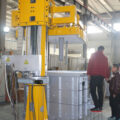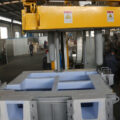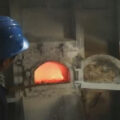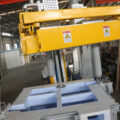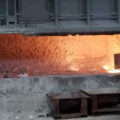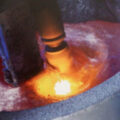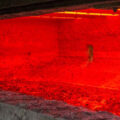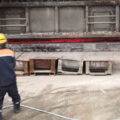Degassing with Nitrogen has been gradually eliminated in the modern aluminum industry, fluxes are generally used together with nitrogen.
Use active gas chlorine as a purifying agent (chlorination method). In the chlorination method, when the chlorine gas is passed into the aluminum liquid, a lot of abnormally small bubbles are generated, which are fully mixed in the aluminum liquid. The hydrogen dissolved in the molten aluminum and some mechanical inclusions are adsorbed on the AlCl3 bubbles and are discharged as the bubbles rise to the surface of the molten aluminum. When chlorine gas is introduced, some elements that are more negative than aluminum can be chlorinated, such as calcium, sodium, magnesium, etc., which are separated into corresponding chlorides due to the introduction of chlorine gas. Therefore, the chlorination method is a very effective purification method. The amount of chlorine gas is 500-700g per ton of aluminum. But because chlorine gas is toxic and expensive, in order to avoid air pollution and reduce the cost of aluminum ingot production, this method has been gradually eliminated in the modern aluminum industry and changed to an inert gas-nitrogen purification method.
The inert gas mentioned here refers to the gas that does not react chemically with the molten aluminum and the gases and impurities dissolved in the molten aluminum, and does not dissolve in the molten aluminum itself. For example, Degassing with Nitrogen. The molten aluminum is continuously fed into the purification furnace and flushed by nitrogen, so the non-metallic inclusions and dissolved hydrogen in the molten aluminum are removed, and then continuously discharged, so that the fine nitrogen bubbles are evenly distributed in the treated molten aluminum The nitrogen used for aluminum degassing is non-polluting to the atmosphere, and the purification capacity is large. Degassing with Nitrogen can process 200~600kg aluminum liquid per minute, and the aluminum loss caused by the purification process is relatively reduced, so it is widely used.
Degassing with Nitrogen
First, after nitrogen is blown into the melt, a large number of nitrogen bubbles are produced. On the contact surface of the bubble and the molten metal, there is only nitrogen in the bubble at the beginning, but due to the pressure, the hydrogen in the melt enters the nitrogen bubble, and the nitrogen bubble containing hydrogen rises to the liquid surface under the action of buoyancy. Ran into the atmosphere, thus taking away hydrogen from the metal. In order to ensure that the gas is fully discharged, the nitrogen bubbles that are blown in should be slowly raised during operation, and the contact area between the bubbles and the metal should be as large as possible. For this reason, the volume of the blown bubbles must be as small as possible. This will bring out a lot of gas. For the nitrogen to be blown in, one must be very pure and free of other gas impurities; the other is to contain the least amount of water. When nitrogen is used for refining, the degassing speed is slow, it is impossible to remove the gas in the metal, and the purification effect on non-metal impurities is very small. Fluxes are generally used together with nitrogen, which will increase the degassing effect
Due to the large area of aeration in the molten aluminum furnace, the gas distribution is difficult to be uniform, the bubbles rise too fast, and the large amount of flux is used to cause bad working conditions and environmental consequences. In the process of recasting the purified molten aluminum, an oxide film is formed due to the rapid destruction of molten aluminum, which increases the possibility of slag inclusion in the ingot. Therefore, in recent years, in the continuous casting technology of aluminum and aluminum alloys, the purification treatment of aluminum liquid has appeared in the combination of filtration and air blowing outside the furnace. The purified molten aluminum can be cast.



